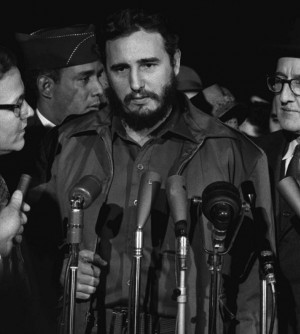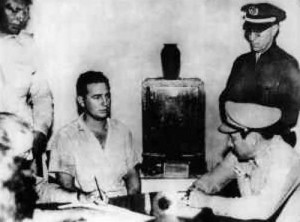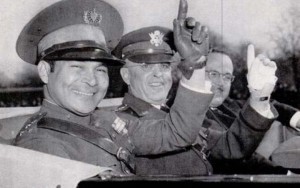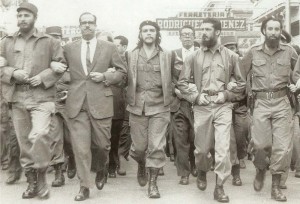| Fidel Castro | |
|---|---|
 |
|
| President of Cuba | |
| In Power | 1959-2008 |
| Born | Aug. 13, 1926 Biran |
| Nationality | Cuban |
| Political Affiliation | Communist/Socialist |
Fidel Castro was a Cuban dictator who used the guerilla warfare in 1959 to overthrow the Cuban leader Batista to become the prime minister of Cuba. During his tenure as the prime minister he established economic and covert military relations with the Soviet Union which led to the Cuban Missile Crisis. In 1976, he became the president of Cuba.
Early Life
Fidel Alejandro Ruz was born near Biran in the eastern province of Cuba on August 13, 1926. He was the third son in a family of six children including two brothers, Ramon and Raul, and three sisters, Augustina, Emma, and Angelita. He was the son of Angel Castro y Argiz, a Spaniard and a rich sugar plantation owner in Cuba. His mother, Lina Ruz Gonzalez, was a maid to the first wife of Angel, Luisa Argota. When Fidel was 15 years of age, his father dissolved his marriage to Luisa and married Fidel’s mother. Later when Fidel was 17, his father recognized him formally and his name was changed from Ruz to Castro.
Fidel was brought up in a wealthy background amidst the impoverished conditions of the people of Cuba. He attended the private Jesuit boarding schools and was intellectually gifted, though he liked sports more than studies. He joined El Colegio De Belen and became the best player of the school’s baseball team. He graduated in 1945 and progressed to the school of law in the University of Havana where he was exposed to the politics of Cuban nationalism, socialism, and anti-imperialism.
Early Political Rebellions and Arrests
 Fidel became more passionate and involved with social justice in 1947. He joined an expedition in Dominican Republic which was trying to overthrow the dictator of Cuba, Rafael Trujillo. Unfortunately, this coup failed before it even started.
Fidel became more passionate and involved with social justice in 1947. He joined an expedition in Dominican Republic which was trying to overthrow the dictator of Cuba, Rafael Trujillo. Unfortunately, this coup failed before it even started.
When he returned to the University of Havana, he joined an anti-communist political party by the name Parti Ortodoxo, which was formed to reform corruption cases in the Cuban government. It was founded by a Cuban presidential candidate, Eduardo Chibas, who had lost the 1948 elections and its goals included social reforms, economic independence, and nationalism. In 1951, Chibas ran for presidency once more with the cause to expose the corruption in the government and warn Cuban people about the plan by former president, General Fulgencio Batista, to return to power. Unfortunately Chibas failed once more after some allies failed to provide evidence against the government’s misconduct. This caused Chibas to shoot himself during a radio broadcast as a punishment for failing his people.
Castro married Mirta Diaz Balart in 1948. Together they bore one child by the name Fidelito. This marriage exposed Castro to more political connections and a wealthier lifestyle. He later vied for a parliamentary seat but a coup headed by General Fulgencio overthrew the government and annulled the elections. The results of these events placed Castro in a lifestyle of little income and no legitimate political platform. He was unable to support his family eventually leading to the end of his marriage in 1955.
General Batista made himself a dictator. He solidified his relationship with the Cuban economic elite and the military, making his government recognized by the U.S. Castro together with other members of the Ortodoxo party who failed to win the 1952 elections planned an insurrection. On the 26th of July in 1953, Castro, together with another 150 supporters, attacked the military barracks at Moncada in an attempt to overthrow Batista. Unfortunately this coup failed, leading to the arrest of Castro. He was tried and sentenced to prison for 15 years.
Guerilla War
 In 1955 an amnesty deal was struck with Batista government and Castro was released. He travelled to Mexico and met Ernesto “Che” Guevara who helped him devise a strategy for overthrowing Batista using a guerrilla warfare approach. According to Guevara, the plight of the poor Latin America could only be rectified by the use of violent revolution.
In 1955 an amnesty deal was struck with Batista government and Castro was released. He travelled to Mexico and met Ernesto “Che” Guevara who helped him devise a strategy for overthrowing Batista using a guerrilla warfare approach. According to Guevara, the plight of the poor Latin America could only be rectified by the use of violent revolution.
On December 2, 1956, Castro went back to Cuba through the eastern city of Manzanillo with a boatload of 81 insurrectionists. Within a short time, Batista captured or killed most of the rebels. Castro was able to escape together with his brother Raul and Guevara and they ran to Sierra Maestra Mountain range. In the next 2 years, Castro’s guerilla forces rebelled against the government of Batista, organizing resistance groups in small towns and cities across Cuba. Castro also ran a parallel government and controlled provinces rich in manufacturing and agricultural production.
In 1958, Castro’s forces launched major attacks on the Batista government, capturing key areas in the country. Soon Batista’s government collapsed and, in January of 1959, he fled to the Dominican Republic. This marked the success of Castro’s guerilla campaign, and at age 32, he took control of Cuba. This led to the establishment of a new government and the appointment of a new Prime Minister by the name Jose Miro Cardona. The new government was soon recognized by the U.S., and when Castro arrived in Havana, he took over as the commander-in-chief of the military. Miro suddenly resigned in February and Castro became the Prime Minster.
The Change to Communism
Castro made changes in the government by nationalizing the plantations and factories with the purpose of ending U.S. dominance on the island. This led to friction between the two countries. Castro denied practicing communism but Americans believed his policies were the same as the Soviet-style of controlling government and economy. In April of 1959, he visited the U.S. together with his delegates as invitees to the National Press club. He hired a popular public relations firm in the U.S. to promote his tour but President Dwight Eisenhower refused to meet him.
In May the same year, Fidel signed the first Agrarian Reform Law. This rule restricted the size of land properties one could own and forbade foreigners from owning land. The intention was to make the farmers independent but in essence the government controlled the properties and the farmers became mere employees of the government. By the end of his first year in power, he had radicalized his revolution, suppressing any critic of his policies in the media and purging any military or political leaders that criticized his way of ruling.
Castro established a relationship with the Soviet Union and received more than 100 advisors from USSR to help him organize his defense committee. He signed a trade treaty in February of 1960 to buy oil from the Soviet Union. As a result the refineries owned by the U.S. stopped processing oil so Castro confiscated the refineries. The U.S. reacted by cutting the sugar import quota from Cuba.
The Missile Crisis
 On January 3, 1961, Dwight Eisenhower broke off the diplomatic relations between the 2 countries. On April 16th, Castro officially declared Cuba as a socialist state. The next day, 1400 Cuban exiles attacked the Bay of Pigs to overthrow the regime of Castro. The attempt failed and 1,000 insurgents were captured with hundreds being killed. The U.S. denied any involvement in the attack but it was later revealed that it was the Central Intelligence Agency that trained the insurgents and armed them with U.S. weapons.
On January 3, 1961, Dwight Eisenhower broke off the diplomatic relations between the 2 countries. On April 16th, Castro officially declared Cuba as a socialist state. The next day, 1400 Cuban exiles attacked the Bay of Pigs to overthrow the regime of Castro. The attempt failed and 1,000 insurgents were captured with hundreds being killed. The U.S. denied any involvement in the attack but it was later revealed that it was the Central Intelligence Agency that trained the insurgents and armed them with U.S. weapons.
This made Castro stricter in his policies. On May 1st of that year, he declared the end of democratic elections in Cuba. At the end of the year he announced himself as a Marxist-Leninist and adopted communist political and economic policies in Cuba. On February 7, 1962, the U.S. instated a full economic embargo on Cuba, a ban that has continued to this day.
Castro improved his relationship with the Soviet Union and got more military and economic aid. In October of 1962, his reliance on the Soviet Union almost sparked the start of a nuclear war. The premier of Soviet, Nikita Khrushchev placed nuclear missiles in Cuba only 90 miles from the cost of Florida in response to the U.S. placing Jupiter missiles in Turkey.
However an American U2 exploration plane discovered the construction base before the missiles were installed. As a result, President Kennedy demanded the removal of these missiles and ordered the U.S. navy to search for any vessel that may be headed to the island.
After secret discussions between Kennedy, Khrushchev, and their agents, the nuclear missiles were removed in exchange for a public declaration by Kennedy not to invade Cuba. Also the Kennedy administration agreed to remove the Jupiter missiles in Turkey secretly. Both leaders saved face without involving Castro in the negotiation.
Cuba Under Castro
In 1965, Castro merged his revolutionary organizations with the Communist party and made himself the leader. In the next few years he started a campaign to support the armed struggle in African and Latin American countries against imperialism. In 1966, he created the Asia-Africa-Latin American Solidarity Organization which promoted revolution in the 3 continents. Again in 1967, he founded the Latin America Solidarity Organization which fostered revolution in some Latin-American countries. Through the 1970s, he made himself the leading spokesperson for third world countries and provided military support to the pro-soviet forces in Yemen, Ethiopia, and Angola.
The agreement by the U.S not to invade Cuba did not entirely limit them from trying to end Castro’s regime. According to the Cuban Intelligence, Castro was a target for CIA assassination attempts which totaled 638 over the years. In fact Castro once said that if avoiding the assassination attempts were Olympic competition, he would have won many gold medals.
Not all of Castro’s policies were criticized. Under his regime he opened 10,000 schools and increased the literacy level to 98%. Infant mortality also decreased to 1.1% and Cubans enjoyed a health-care system. Still, civil liberties were whittled away following the shutdown of independent newspapers, the loss of the right to strike by the labor unions, and the harassment of religious institutions.
During his reign, many Cubans fled to Florida Straits in Miami, especially in 1980 when he opened the port of Mariel to the exiles for claiming their relatives. He loaded the ships with mental patients, prison inmates, and other social undesirables. In total almost 120,000 Cubans fled Cuba to find sanction in the U.S.
The Collapse of the Soviet Union
When the Soviet Union collapsed in 1991, the economy of Cuba went into a tailspin. They lost their cheap oil imports, and their sugar exports to the Soviet Union deteriorated, leading to high unemployment rates and inflation. In fact, Cuba lost almost 85% of its entire market.
Castro appealed to the U.S. to lift the economic embargo but the request was rejected. He then adopted a quasi-fee economy which encouraged international investment. Castro made the U.S. dollar legal and encouraged tourism. In 1996, he visited the U.S. and invited the Cubans living there to come back home and start their own businesses.
After Hurricane Michelle in 2001 which caused massive damage, he refused to get humanitarian aid from U.S. but instead proposed a one-time cash purchase of food. The administration of George W. Bush complied and shipped food to Cuba. Later when the fuel ran below the minimum level, Castro ordered the closure of 118 factories and imported oil from Venezuela in exchange of thousands of Cuban doctors.
Decline in Health
His well-being and age was questioned in the late 1990s, but it became more significant in 2006 when he underwent a surgery for gastrointestinal bleeding. During this time, he named his brother Raul as temporary leader of Cuba. Since this surgery, people have only seen Castro in video and photographs.
On February 19, 2008, he permanently gave up his presidency to his brother Raul as a result of his deteriorating health. In his retirement, he spends his time as a columnist and publishes the popular column known as Reflections of Fidel.